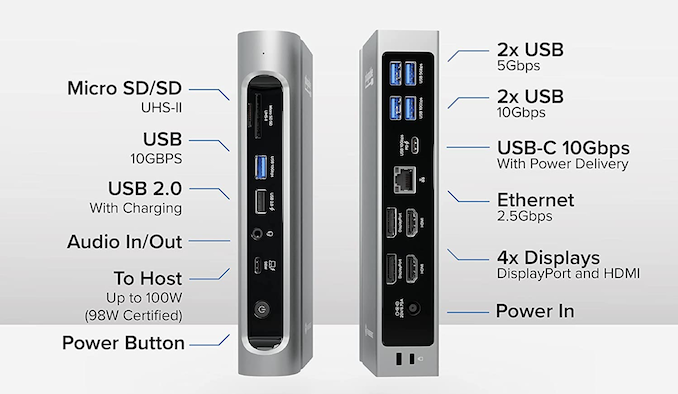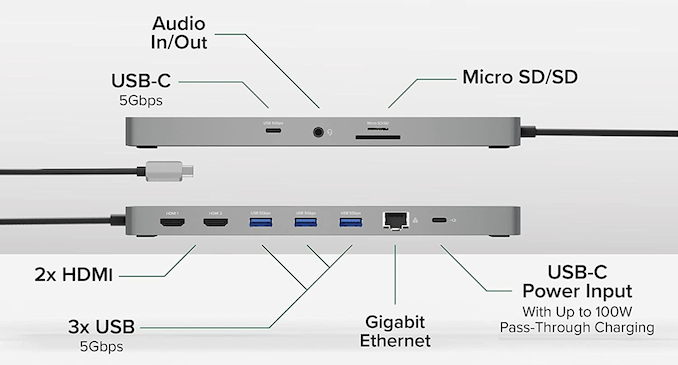CES 2023: Plugable Introduces New Flagship Thunderbolt 4 Dock and USB-C Hub
by Ganesh T S on January 4, 2023 6:00 AM EST- Posted in
- Trade Shows
- CES
- USB-C
- Plugable
- USB4
- Thunderbolt 4
- CES 2023

The Thunderbolt and USB ecosystems have seen rapid updates over the last couple of years. In 2022, we saw the announcement of the USB4 v2 standard and some details of Next Generation Thunderbolt with total bidirectional speeds of up to 160 Gbps (80 Gbps TX / RX with symmetric links, and 120 Gbps TX / 40 Gbps RX using asymmetric links from the host perspective). Product introductions have typically lagged behind the announcement of the standards by 18 - 24 months, and we are currently in the midst of the introduction of the second wave of Thunderbolt 4 and USB4 products.
At CES 2023, Plugable is introducing its first Thunderbolt 4 dock - the TBT4-UDZ. One of the key updates in Thunderbolt 4 was the bridging of features common in the USB world. Consequently, the first-generation products were focused on delivering the newly introduced hub functionality to users. Plugable had launched the highly appreciated TBT4-HUB3C back in September 2021 to cover that aspect. The TBT4-UDZ being announced today is a flagship dock equipped with the Intel Goshen Ridge controller. It provides 16 additional ports and host charging up to 100W. There are four additional display outputs (2x HDMI 2.0 + 2x Display Port 1.4), though the number of actual displays that can be driven depends on the host's capabilities.
The 2.5 Gbps NBASE-T port is a welcome addition to the feature set of Thunderbolt docks. It is something that we are seeing in most of the newly-launched Thunderbolt 4 docks from different vendors. Despite the presence of a large number of useful ports, a downstream Thunderbolt port is conspicuous by its absence. Though this dock can be connected to one of the Thunderbolt 4 ports in the TBT4-HUB3C, it might be interesting from a technical perspective to combine both hub and dock functionality into a single device.
Plugable is planning to start shipping the TBT4-UDZ on January 17th, with pre-orders for $299 already active on Amazon.
The USBC-11IN1E is Plugable's flagship USB-C hub, and a follow-up to the USBC-7IN1E introduced in 2020 and updated in 2021 with newer internals and I/Os. The additional ports do add to the price - the 11-port version is priced at $79, compared to the $40 of the 7-port version.
The hub requires the host's USB-C port to support MST on the DP Alt Mode output to enable both HDMI ports. Without MST, usage of the DP Alt Mode results in the mirroring of the display outputs. The hub retains the USB-C power input (to which the notebook's original charger can be connected for passthrough charging).
Plugable is also adding 1m (3.3ft) Thunderbolt 4 and USB4 passive cables to its product portfolio. The new cables support 40 Gbps speeds and 240W charging (Extended Power Range). The Thunderbolt-certified TBT4-240W-1M is priced at $29.25, while the USB-IF-certified USB4-240W-1M is priced at $25.95. The price difference seems solely due to the difference in certification costs - it is likely that the USB-IF certified cable will work just as well with Thunderbolt 4 setups.
Source: Plugable












9 Comments
View All Comments
Exotica - Wednesday, January 4, 2023 - link
No downstream thunderbolt 4 ports = a massive no thank you.scott967a - Wednesday, January 4, 2023 - link
Dunno. I don't have requirement for TB passthrough. My problem as a consumer is it is hard to understand exactly what the laptop supports and what the hub/dock output protocol levels are. The longer cable is nice. Don't need a 1m cable but from what I see laptops might have a single usb-c form factor port and the short little stub cables are a problem if the port is on the wrong side, so a bit longer cable (and not so stiff as some docks) makes arranging the hardware easier.questionasker - Friday, January 6, 2023 - link
I agree. I have an 4 year old laptop with USB 3.? and TB3 over USB-C. I know I need to figure out exactly what my laptop supports, but I'm unclear if these new USB4/TB4 docks are fully compatible with USB3/TB3. Can I use this dock with my current laptop and still be future proofed for when I next upgrade?hubick - Wednesday, January 4, 2023 - link
Owning a couple OWC docks and the CalDigit hub, this isn't worth the upgrade for me. These things are already insane $$$, so if it's gonna be premium anyhow, I'd like to see a 10 GB Ethernet port (Intel chip). And my high-end camera is using CFexpress cards now, so all these SD readers are meh.PeachNCream - Wednesday, January 4, 2023 - link
It's nice to see improvements, but I haven't been overly concerned about external connectivity speed since USB 3.0 landed at "good enough" and has remained sufficient for my own personal use even now.back2future - Wednesday, January 4, 2023 - link
One need constantly increasing would be external memory ~32-64GB (DDR4 would be sufficient, even with low 10-20Gbps (TB2-TB3) (40Gbps available, perspective to ~80Gbps for next years) connectivity, but low latency&interrupt, for USB-C PCI-e protocols?) and movable between devices if needed (compatibility towards USB3/4).Thinking about cost efficiency a QLC flash PCIe swap device (M.2 connectors for NVME_protocol, newer E1, NGSFF (M.3)) on USB 3.1 would be an instantly available alternative.
kwisatzCA - Wednesday, January 4, 2023 - link
My concern is how the display ports are connected internally...If they use an MST hub inside this makes it incompatible with most enterprise grade KVM switches...I'd like to think they have the bandwidth with USB4/TB4 to provide at least 2 discrete channels to properly provide EDID info to external KVMsDigitalFreak - Wednesday, January 4, 2023 - link
https://kb.plugable.com/question/1705024DanaGoyette - Sunday, January 8, 2023 - link
Count me out for both of these reasons. I use one display for both gaming and work, so I need 4k120 and adaptive sync."We do not officially support high refresh rate displays above 60Hz. (higher refresh rates under 4K resolution may be selected but performance and stability above 60Hz is not guaranteed)"
"We do not support HDR (High Dynamic Range) or adaptive sync/variable refresh rate (such as AMD FreeSync or Nvidia G-Sync technologies)"
But I have to thank them for clearly answering questions that most vendors don't bother even thinking about. With many vendors, their sites don't say squat about refresh rate or adaptive sync, and if you ask the seller on Amazon, they'll answer some question that wasn't even what you asked.